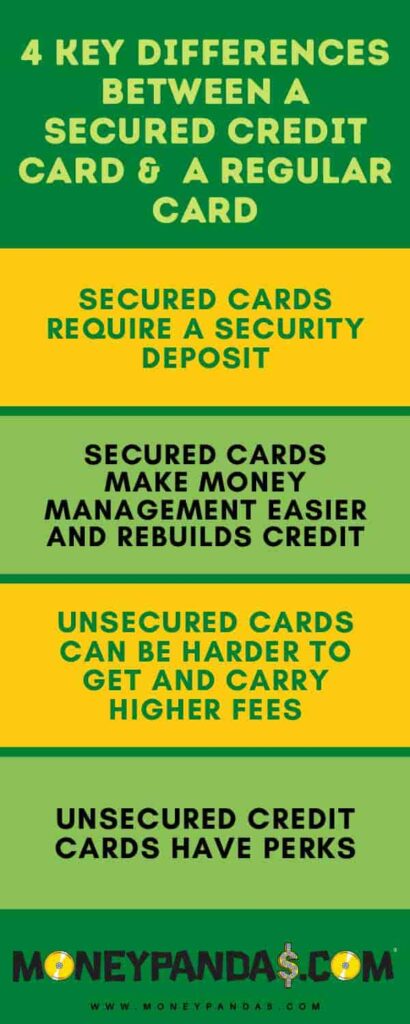4 Key Differences Between a Secured Credit Card and a Regular Card
When it comes to credit cards, there are seemingly endless options to choose from. Picking the right one for your situation can seem daunting. But the biggest decision to start from is whether to go with a secured or unsecured credit card. Both have their advantages and drawbacks, so how can you know which one is right for your financial situation? And what is the major difference between an unsecured and a secured credit card?
Unsecured and secured credit cards have one key difference and a few notable distinctions; a secured credit card requires a deposit to cover the credit limit on the card. Secured cards also tend to have lower fees, fewer perks, and are easier to qualify for than most unsecured credit cards.
Most customers prefer unsecured cards, but secured credit cards play an important role in helping to build credit. Below, we’ll discuss the key differences between secured credit cards and regular cards and the pros and cons of each.
What is the Main Difference Between a Secured Credit Card and a Regular Credit Card?
The primary difference between a secured credit card and a regular credit card is the refundable deposit that you have to send to the card issuer when you open a secured credit card account.
This deposit gives the issuer some assurance that if you should fail to pay your credit balance, they have some funds to cover their losses. This helps reduce their risk and often results in secured credit cards being easier to qualify for than unsecured credit cards.
The deposit is refundable, so you get it back (minus whatever remaining outstanding balance you may have) when you close your account. Usually, these deposits have maximums and minimums between $200 to $3000. Some cards may offer a lower minimum, but bear in mind that the lower your deposit amount, the lower your credit limit.
Which Credit Card is Best, Secured or Unsecured?
Here is a breakdown of the different situations where a secured or unsecured credit would work best:
| Credit History/Rating | Money Management Skills | Best Card Type |
|---|---|---|
| Poor credit history or poor credit score | Weak money management skills or uncertain | Secured |
| Good or decent credit history and/or credit score | Weak money management skills | Secured |
| Good credit history and/or credit score | Strong money management skills | Unsecured |
Whether you should apply for a secured credit card or an unsecured card really depends on your financial and credit situation. But let’s get one thing straight: in terms of building credit, the fact that a card is secured or unsecured will not matter in any meaningful way.
Both types of credit cards can be great for building (or rebuilding) your credit when used in the right way. But there are differences between the two types of cards that can be important depending on your spending habits and how good you are at managing your finances.
When you are new to using credit cards, or if you have struggled to manage your finances in the past, a secured credit card can be a better option:
- A secured credit card is easier to qualify for when you have no credit history or poor credit.
- Having such a card will allow you to show you manage your budget and finances well by making payments on time and avoiding large balances.
- Unsecured credit cards can carry higher interest rates and fees than secured credit cards for those with less than ideal credit.
How Long Does It Take for a Secured Credit Card to Become Unsecured?
It usually takes at least a year until a bank may offer to transition you onto an unsecured card from a secured card, depending on whether you have made payments consistently on time and kept your utilization ratio low.
In other words, you’ll want to manage these factors to ensure you’re offered a chance to transition to an unsecured card:
- Regular, On-Time Payments – Paying only the minimum deposit or a little over each month is a good way to keep your credit limit small and help you avoid overspending. However, you need to be careful about using too much of your credit limit to avoid having too high a credit utilization ratio.
- Low Credit Utilization Ratio – A credit utilization ratio is the percentage of your overall credit limit that you are using at any given time. Credit utilization is a metric that plays an important role in your credit score, and having one that is too high can adversely affect your credit rating. Generally, you want to stay under 30% of credit utilization.
For example, if you have a $200 credit limit, you would not want to carry a balance of more than $60 on your card. So it’s fine to pay only the minimum security deposit, but you will have to be extra careful to keep your balance at or below 30%, which might be difficult if your limit is very low.
Should I Switch from a Secured to Unsecured Credit Card?
Whether or not you decide to transition to an unsecured card when given the opportunity is up to you, but it usually means getting your security deposit back, which can be a big plus.
Before making this switch, review the terms and conditions for the unsecured credit card account and see if they make sense for your financial situation. Be especially careful to understand what fees will apply (including late fees) as well as interest rates.
4 Key Differences Between a Secured Credit Card and a Regular Card

Secured Cards Require a Security Deposit
When you open a secured credit card account, you are required to pay a security deposit. For instance, if you apply for a card with a $2000 credit limit, then you would submit a deposit of $2000 when you have been approved. When you make purchases, you would still make payments to cover your balance each month.
The difference is mainly for the issuer’s benefit: if you cannot make your payments, they have your security deposit to cover the outstanding balance. Essentially, you are funding the credit limit yourself.
Banks that offer secured credit cards may require the security deposit as soon as you have been approved to move forward, or they may allow you to delay paying the deposit for some time. Others may require you to open a savings account with the same bank and link it to the card. In any case, some form of a security deposit must be paid, or your application can be rejected or your account closed.
Why is a Security Deposit Necessary?
The purpose of the security deposit is to minimize risk to the card issuer. An unsecured card puts the risk on the bank issuing the card. If you never pay off the balance, perhaps because you declared bankruptcy, their risk is basically zero because you already covered your limit upfront.
Banks issuing credit cards want to know that their customers pose less risk to them, so they are more likely to approve a secured card than an unsecured one when the customer has either an unknown credit history or a poor credit history or rating.
Secured Cards Make Money Management Easier and Rebuilds Credit
When you are applying for a credit card, and your credit has been less than ideal, you will often find it is easier to qualify for a secured card. A credit card is a great tool for building up your credit score in the following ways:
- Your available credit is increased by the credit limit on your card. This improves your credit utilization rate, which, as mentioned, is an important metric for calculating your credit score.
- It can demonstrate that you can manage multiple accounts, which increases confidence in your financial management.
- If you regularly make payments on time, you will drive up your credit score by showing you are a responsible payee.
When you are rebuilding your credit, a secured credit card can be an excellent option, provided you have the money to pay the security deposit. These cards can be easier to qualify for when you have poor credit, and having a credit card and managing it well can be a great tool for rebuilding your credit. (These cards are sometimes referred to as “second chance cards” for that reason.)
Unsecured Cards Can Be Harder to Get and Carry Higher Fees
While unsecured credit cards are preferred by most consumers because there is no security deposit needed, they can carry some downsides.
If you don’t qualify for a premium credit card, the unsecured cards you may qualify for will usually carry higher fees and interest rates. Both can ultimately lead you deeper into debt if you are not careful to manage them carefully, and such cards are less forgiving when you fall behind in payments. If managed poorly, they can lead to a cycle of late fees and balances that grow ever faster due to interest carried from month to month.
Unsecured Credit Cards Have Perks
Despite their high fees, unsecured credit cards often come with perks that you may not find on secured credit cards. These can be things like points you earn for spending with your card that can be redeemed for purchases or discounts. Sometimes the number of points you earn can be much higher for certain types of purchases, such as fuel or restaurants, so if you engage in these activities a lot, they can be a good thing to consider when deciding on which card to get.
Many unsecured cards also offer things like travel insurance (for instance, covering up to a certain amount for rental car damage or other travel losses). That’s not to say that there are no secured credit cards that come with such perks, but they are more common and generous with unsecured cards. These are among the reasons unsecured cards are preferred by many customers.
If your credit is good, and you have a good handle on managing your money, then you probably will want to apply for an unsecured credit card in most such cases. One thing a good secured credit card should offer is cashback rewards.
Conclusion
Both secured and unsecured cards have their pros and cons, but a secured card can be a good option for people starting with no prior credit history or who have struggled with credit in the past. However, both are on par with each other for building credit since that is really more about managing your money and credit wisely over what type of card you have.
The most important consideration is to make sure you understand your obligations with any credit card you pursue and what fees and interest rates they charge before committing to anything. If you take your time to review your financial situation and choose carefully, you can end up with a credit card that will help you build credit and live within your means.




